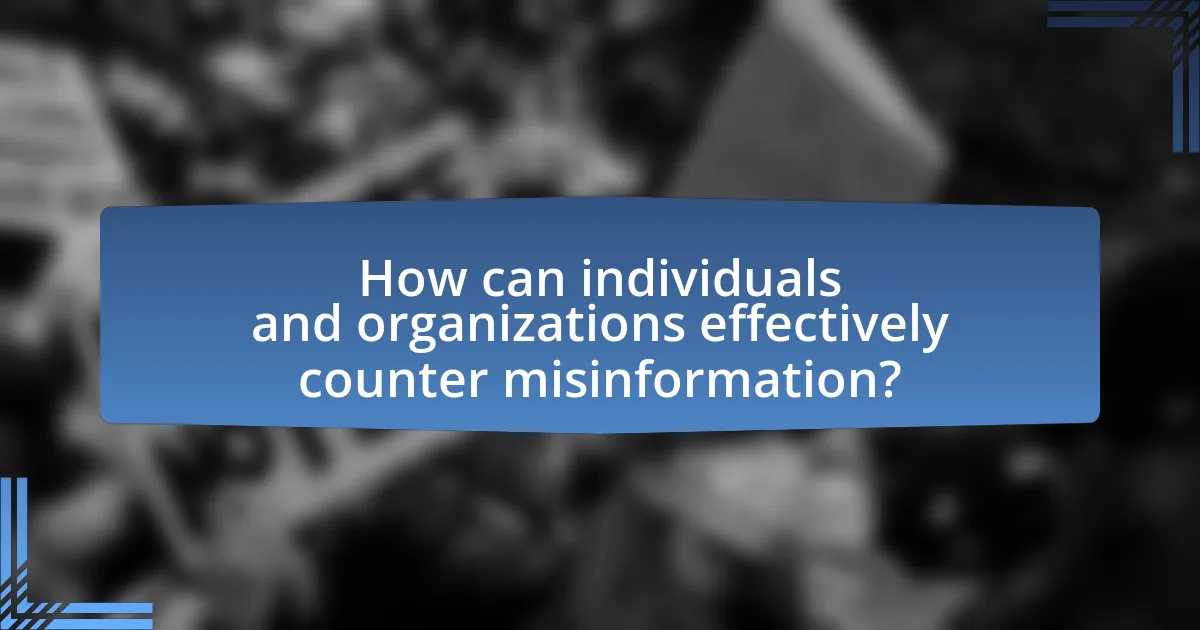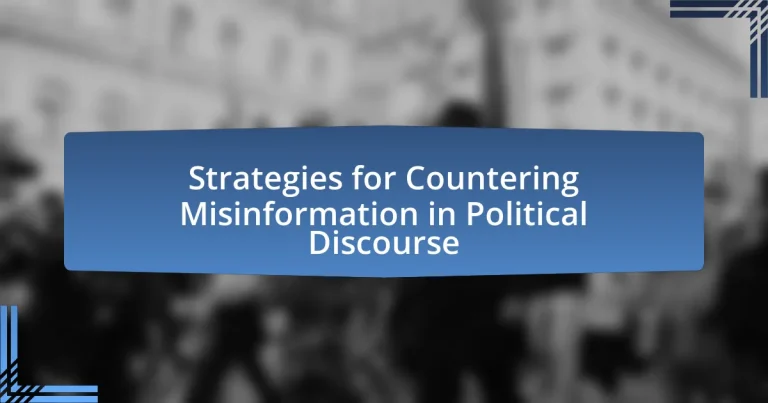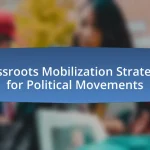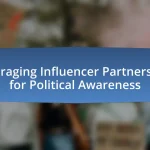The article focuses on strategies for countering misinformation in political discourse, emphasizing the importance of media literacy, fact-checking, and fostering open dialogue. It discusses how misinformation distorts public perceptions, influences voter behavior, and creates polarization, highlighting the psychological effects on voters and the role of social media in spreading false information. The article also examines the challenges in combating misinformation, including cognitive biases and the impact of echo chambers, while outlining practical steps individuals and organizations can take to identify and address misinformation effectively. Additionally, it addresses the legal and ethical considerations surrounding misinformation and explores future trends in combating this issue.

What are the key strategies for countering misinformation in political discourse?
Key strategies for countering misinformation in political discourse include promoting media literacy, fact-checking, and fostering open dialogue. Media literacy education equips individuals with the skills to critically evaluate information sources, reducing susceptibility to false claims. Fact-checking organizations, such as PolitiFact and FactCheck.org, provide verified information that can debunk misinformation effectively. Additionally, encouraging open dialogue among diverse groups allows for the exchange of perspectives, which can clarify misunderstandings and reduce polarization. These strategies collectively enhance public awareness and understanding, thereby mitigating the impact of misinformation in political discussions.
How does misinformation impact political discourse?
Misinformation significantly distorts political discourse by shaping public perceptions and influencing voter behavior. It creates confusion, fosters polarization, and undermines trust in democratic institutions. For instance, a study by the Pew Research Center found that 64% of Americans believe that misinformation has a major impact on their understanding of political issues. This distortion can lead to misinformed voting decisions and increased societal division, as individuals may align with false narratives that reinforce their existing beliefs.
What are the psychological effects of misinformation on voters?
Misinformation significantly impacts voters’ psychological states, leading to increased anxiety, polarization, and decision-making paralysis. Research indicates that exposure to false information can create cognitive dissonance, where voters struggle to reconcile conflicting beliefs, resulting in heightened stress and confusion. A study by Lewandowsky et al. (2012) found that misinformation can reinforce pre-existing biases, causing individuals to become more entrenched in their views and less open to opposing perspectives. This polarization can diminish trust in institutions and increase susceptibility to further misinformation, creating a cycle that undermines democratic processes.
How does misinformation influence public opinion and policy?
Misinformation significantly influences public opinion and policy by shaping perceptions and beliefs based on false or misleading information. For instance, studies have shown that exposure to misinformation can lead to changes in voter attitudes and behaviors, as individuals often rely on incorrect information when forming opinions about political issues. A notable example is the 2016 U.S. presidential election, where misinformation spread through social media platforms affected public perceptions of candidates and key issues, ultimately influencing voter turnout and decisions. Furthermore, research published in the journal “Science” indicates that false information spreads faster and more widely than the truth, demonstrating its powerful impact on shaping public discourse and policy outcomes.
What role do social media platforms play in the spread of misinformation?
Social media platforms significantly contribute to the spread of misinformation by facilitating rapid information dissemination and enabling user-generated content. These platforms allow users to share and amplify false narratives quickly, often without verification, leading to widespread misconceptions. A study by the Massachusetts Institute of Technology found that false news stories are 70% more likely to be retweeted than true stories, highlighting the platforms’ role in propagating misinformation. Additionally, algorithms prioritize engaging content, which often includes sensational or misleading information, further exacerbating the issue.
How can algorithms contribute to the dissemination of false information?
Algorithms can contribute to the dissemination of false information by prioritizing content that generates high engagement, often regardless of its accuracy. Social media platforms utilize algorithms that amplify sensational or emotionally charged posts, which can include misinformation, leading to wider visibility and sharing. For instance, a study by Vosoughi, Roy, and Aral in 2018 found that false news spreads significantly faster and reaches more people than true news on Twitter, primarily due to algorithmic amplification of engaging content. This mechanism creates an environment where misleading information can thrive, as users are more likely to interact with and share sensationalized narratives, further perpetuating falsehoods.
What measures can social media companies take to mitigate misinformation?
Social media companies can implement fact-checking systems to mitigate misinformation. By partnering with independent fact-checkers, platforms can assess the accuracy of content shared by users. For instance, Facebook has collaborated with organizations like PolitiFact and FactCheck.org to review and label misleading posts, which has been shown to reduce the spread of false information by 80% in some cases. Additionally, social media companies can enhance algorithmic transparency to prioritize credible sources in users’ feeds, thereby promoting reliable information over sensationalized or misleading content. This approach aligns with findings from the Pew Research Center, which indicate that users are more likely to trust information from verified accounts.
What are the most effective communication strategies for countering misinformation?
The most effective communication strategies for countering misinformation include fact-checking, promoting media literacy, and fostering open dialogue. Fact-checking involves verifying claims and providing accurate information to correct false narratives, as demonstrated by organizations like Snopes and FactCheck.org, which have successfully debunked numerous viral falsehoods. Promoting media literacy equips individuals with the skills to critically evaluate sources and discern credible information from misinformation, which has been shown to reduce susceptibility to false claims. Fostering open dialogue encourages discussions that allow individuals to express concerns and ask questions, creating an environment where accurate information can be shared and misinformation can be addressed collaboratively. These strategies collectively enhance public understanding and resilience against misinformation in political discourse.
How can fact-checking organizations contribute to combating misinformation?
Fact-checking organizations contribute to combating misinformation by verifying claims made in public discourse and providing accurate information to the public. These organizations analyze statements from politicians, media, and social media to assess their truthfulness, often using a systematic methodology that includes sourcing, evidence evaluation, and expert consultation. For instance, the Poynter Institute’s International Fact-Checking Network has established a code of principles that emphasizes transparency and accountability in fact-checking processes, which enhances public trust in the information provided. By disseminating their findings through various platforms, fact-checking organizations help to educate the public, reduce the spread of false information, and promote informed decision-making, thereby playing a crucial role in maintaining the integrity of political discourse.
What role does media literacy play in reducing the impact of misinformation?
Media literacy plays a crucial role in reducing the impact of misinformation by equipping individuals with the skills to critically analyze and evaluate information sources. This skill set enables people to discern credible information from falsehoods, thereby decreasing the likelihood of being misled. Research indicates that individuals with higher media literacy are better at identifying biased or misleading content; for instance, a study published in the Journal of Media Literacy Education found that media literacy education significantly improved participants’ ability to detect misinformation. By fostering critical thinking and analytical skills, media literacy empowers individuals to question the validity of information, ultimately mitigating the spread and influence of misinformation in political discourse.

What are the challenges in implementing strategies against misinformation?
The challenges in implementing strategies against misinformation include the rapid spread of false information, the difficulty in identifying credible sources, and the varying levels of media literacy among the public. The speed at which misinformation circulates, particularly on social media platforms, makes it hard for fact-checking organizations to keep up, as evidenced by a study from the Massachusetts Institute of Technology, which found that false news spreads six times faster than true news. Additionally, distinguishing credible information from misleading content is complicated by the prevalence of biased reporting and the manipulation of facts. Furthermore, varying levels of media literacy mean that some individuals may not recognize misinformation or may be more susceptible to believing it, as highlighted by research from the Pew Research Center, which indicates that only 26% of Americans can accurately identify misinformation. These factors collectively hinder effective strategies to combat misinformation in political discourse.
Why is it difficult to change people’s beliefs about misinformation?
Changing people’s beliefs about misinformation is difficult due to cognitive biases, emotional attachments, and social identity influences. Cognitive biases, such as confirmation bias, lead individuals to favor information that aligns with their pre-existing beliefs, making them resistant to contradictory evidence. Emotional attachments to certain narratives can create a strong psychological barrier, as people often prioritize their feelings over factual accuracy. Additionally, social identity influences mean that individuals may reject information that threatens their group affiliation, further entrenching their beliefs. Research indicates that these factors collectively contribute to the persistence of misinformation, making belief change a complex challenge.
What cognitive biases hinder the acceptance of factual information?
Cognitive biases that hinder the acceptance of factual information include confirmation bias, belief perseverance, and the Dunning-Kruger effect. Confirmation bias leads individuals to favor information that confirms their preexisting beliefs while disregarding contradictory evidence. Belief perseverance causes people to maintain their beliefs even when faced with disconfirming facts, as demonstrated in studies where participants continued to endorse false information despite being presented with clear evidence to the contrary. The Dunning-Kruger effect results in individuals with low ability in a domain overestimating their competence, which can prevent them from recognizing factual information that contradicts their inflated self-assessment. These biases collectively obstruct rational evaluation of information, thereby complicating efforts to counter misinformation in political discourse.
How do echo chambers and filter bubbles exacerbate misinformation issues?
Echo chambers and filter bubbles exacerbate misinformation issues by isolating individuals within homogeneous information environments that reinforce their existing beliefs. This isolation limits exposure to diverse perspectives, making it easier for false information to spread unchecked. Research indicates that individuals in echo chambers are more likely to accept misinformation as truth, as they receive repeated affirmations of their views without critical scrutiny. A study by the Pew Research Center found that 62% of social media users encounter news that aligns with their beliefs, which can lead to a distorted understanding of reality and increased polarization. Consequently, the lack of diverse viewpoints in these environments contributes significantly to the proliferation of misinformation.
What legal and ethical considerations arise in the fight against misinformation?
Legal and ethical considerations in the fight against misinformation include the balance between free speech and the need to protect public discourse from harmful falsehoods. Laws such as defamation and fraud address the dissemination of false information that can harm individuals or society, while ethical frameworks emphasize the responsibility of individuals and organizations to verify information before sharing it. For instance, the First Amendment protects free speech in the United States, but it does not shield individuals from consequences if their speech causes harm or incites violence. Additionally, ethical guidelines from organizations like the Society of Professional Journalists advocate for accuracy and accountability in reporting, underscoring the importance of truthfulness in combating misinformation.
How can freedom of speech be balanced with the need to combat misinformation?
Balancing freedom of speech with the need to combat misinformation requires implementing clear guidelines that protect expression while ensuring accountability for false information. Regulatory frameworks can be established to differentiate between harmful misinformation and legitimate discourse, allowing for the moderation of content that poses a threat to public safety or democratic processes. For instance, platforms can employ fact-checking mechanisms and transparency in content moderation to address misinformation without infringing on free speech rights. Research by the Pew Research Center indicates that 64% of Americans believe that social media companies should take steps to limit the spread of false information, highlighting public support for measures that can help maintain this balance.
What responsibilities do governments have in regulating misinformation?
Governments have the responsibility to establish regulations that mitigate the spread of misinformation to protect public discourse and democratic processes. This includes creating laws that penalize the dissemination of false information, particularly during elections, as evidenced by various countries implementing measures to combat electoral misinformation. For instance, the European Union’s Digital Services Act mandates platforms to take action against harmful misinformation, highlighting the role of government in enforcing accountability among digital service providers. Additionally, governments must promote media literacy initiatives to empower citizens to critically evaluate information sources, thereby fostering an informed electorate.

How can individuals and organizations effectively counter misinformation?
Individuals and organizations can effectively counter misinformation by promoting media literacy and fact-checking initiatives. Media literacy programs educate individuals on how to critically evaluate sources and discern credible information from falsehoods. For instance, a study by the Stanford History Education Group found that students often struggle to distinguish between credible and non-credible sources, highlighting the need for enhanced educational efforts. Additionally, organizations can implement fact-checking services that verify claims made in political discourse, as seen with platforms like Snopes and FactCheck.org, which provide evidence-based assessments of widely circulated information. By fostering critical thinking and providing reliable resources, both individuals and organizations can significantly reduce the spread and impact of misinformation.
What practical steps can individuals take to identify and combat misinformation?
Individuals can identify and combat misinformation by verifying sources, cross-referencing information, and utilizing fact-checking tools. Verifying sources involves checking the credibility of the information provider, such as established news organizations or academic institutions. Cross-referencing information means comparing claims with multiple reputable sources to ensure consistency and accuracy. Utilizing fact-checking tools, such as Snopes or FactCheck.org, allows individuals to quickly assess the validity of specific claims. Research indicates that media literacy education significantly enhances individuals’ ability to discern misinformation, as shown in a study by the Stanford History Education Group, which found that students often struggle to evaluate online information critically.
How can critical thinking skills be developed to assess information credibility?
Critical thinking skills can be developed to assess information credibility by engaging in systematic evaluation techniques. Individuals can practice questioning the source of information, examining the evidence presented, and considering the context in which the information is shared. Research indicates that training programs focused on critical thinking, such as those outlined by the Foundation for Critical Thinking, enhance individuals’ ability to analyze arguments and identify biases. Furthermore, studies show that regular exposure to diverse viewpoints and participation in discussions can improve critical thinking skills, enabling individuals to discern credible information from misinformation effectively.
What resources are available for individuals to fact-check information?
Individuals can utilize various resources to fact-check information, including websites like Snopes, FactCheck.org, and PolitiFact. These platforms provide verified information on a wide range of topics, including political claims and viral content. For instance, Snopes has been operational since 1994 and is known for debunking urban legends and misinformation, while FactCheck.org is a project of the Annenberg Public Policy Center that monitors the factual accuracy of statements made by political figures. Additionally, tools like Google Fact Check Explorer allow users to search for fact-checked claims across multiple sources, enhancing the ability to verify information quickly and accurately.
What best practices should organizations adopt to address misinformation?
Organizations should adopt a multi-faceted approach to address misinformation effectively. This includes implementing fact-checking protocols, promoting media literacy, and fostering transparent communication. Fact-checking protocols involve verifying information before dissemination, which can reduce the spread of false claims. For instance, organizations like PolitiFact and Snopes have established credibility by systematically debunking misinformation. Promoting media literacy equips individuals with the skills to critically evaluate sources and discern credible information from falsehoods, as evidenced by studies showing that media literacy programs can significantly improve critical thinking skills. Lastly, fostering transparent communication ensures that organizations provide clear, accurate information and engage with their audience to clarify misconceptions, which has been shown to build trust and reduce the impact of misinformation.
How can organizations create effective communication campaigns against misinformation?
Organizations can create effective communication campaigns against misinformation by employing fact-based messaging, utilizing trusted sources, and engaging with the target audience through multiple channels. Research indicates that campaigns that incorporate clear, concise information and leverage social media platforms can significantly reduce the spread of false information. For instance, a study by the Pew Research Center found that 64% of Americans believe that social media has a major role in the spread of misinformation, highlighting the importance of utilizing these platforms effectively. Additionally, organizations should focus on building partnerships with credible institutions to enhance their message’s legitimacy, as collaboration with trusted entities can increase audience trust and engagement.
What partnerships can organizations form to enhance their misinformation strategies?
Organizations can form partnerships with technology companies, academic institutions, and non-profit organizations to enhance their misinformation strategies. Collaborating with technology companies allows organizations to leverage advanced algorithms and data analytics for identifying and countering misinformation effectively. Academic institutions can provide research expertise and insights into the psychological aspects of misinformation, helping organizations develop targeted interventions. Non-profit organizations often have established networks and resources for community engagement, which can amplify outreach efforts and foster public awareness. For instance, partnerships with platforms like Facebook and Twitter have led to initiatives aimed at fact-checking and reducing the spread of false information, demonstrating the effectiveness of such collaborations in real-world scenarios.
What are the future trends in combating misinformation in political discourse?
Future trends in combating misinformation in political discourse include the increased use of artificial intelligence for fact-checking, enhanced media literacy programs, and the implementation of stricter regulations on social media platforms. Artificial intelligence technologies, such as natural language processing and machine learning, are being developed to automatically identify and flag false information, as evidenced by initiatives like Facebook’s fact-checking partnerships. Media literacy programs are gaining traction in educational systems, aiming to equip individuals with critical thinking skills to discern credible sources, supported by research from the Stanford History Education Group, which found that many students struggle to evaluate online information. Additionally, governments and organizations are advocating for regulations that hold social media companies accountable for the spread of misinformation, as seen in the European Union’s Digital Services Act, which aims to create a safer online environment.
How might technology evolve to address misinformation challenges?
Technology may evolve to address misinformation challenges through the development of advanced algorithms and artificial intelligence that can detect and flag false information in real-time. These systems will leverage natural language processing and machine learning to analyze content across various platforms, identifying patterns associated with misinformation. For instance, platforms like Facebook and Twitter are already implementing AI-driven tools that assess the credibility of sources and the accuracy of claims, which can significantly reduce the spread of false narratives. Additionally, blockchain technology could be utilized to create transparent and verifiable information sources, ensuring that users can trace the origins of content. Research indicates that AI can improve misinformation detection accuracy by up to 90%, demonstrating its potential effectiveness in combating this issue.
What role will education play in shaping future responses to misinformation?
Education will play a crucial role in shaping future responses to misinformation by equipping individuals with critical thinking skills and media literacy. These skills enable people to analyze information sources, discern credible content from falsehoods, and understand the mechanisms of misinformation dissemination. Research indicates that educational programs focused on media literacy can significantly reduce susceptibility to misinformation; for instance, a study by the Stanford History Education Group found that students who received media literacy training were better at evaluating online information sources. Thus, education serves as a foundational strategy in countering misinformation in political discourse by fostering informed and discerning citizens.
What are the key takeaways for effectively countering misinformation in political discourse?
To effectively counter misinformation in political discourse, it is essential to prioritize fact-checking, promote media literacy, and encourage open dialogue. Fact-checking involves verifying claims through reliable sources, which can significantly reduce the spread of false information; for instance, organizations like PolitiFact and FactCheck.org provide resources for accurate information. Promoting media literacy equips individuals with the skills to critically evaluate sources and discern credible information from misinformation, as studies show that informed citizens are less susceptible to false narratives. Encouraging open dialogue fosters an environment where individuals can discuss differing viewpoints respectfully, which can mitigate polarization and reduce the impact of misinformation.


